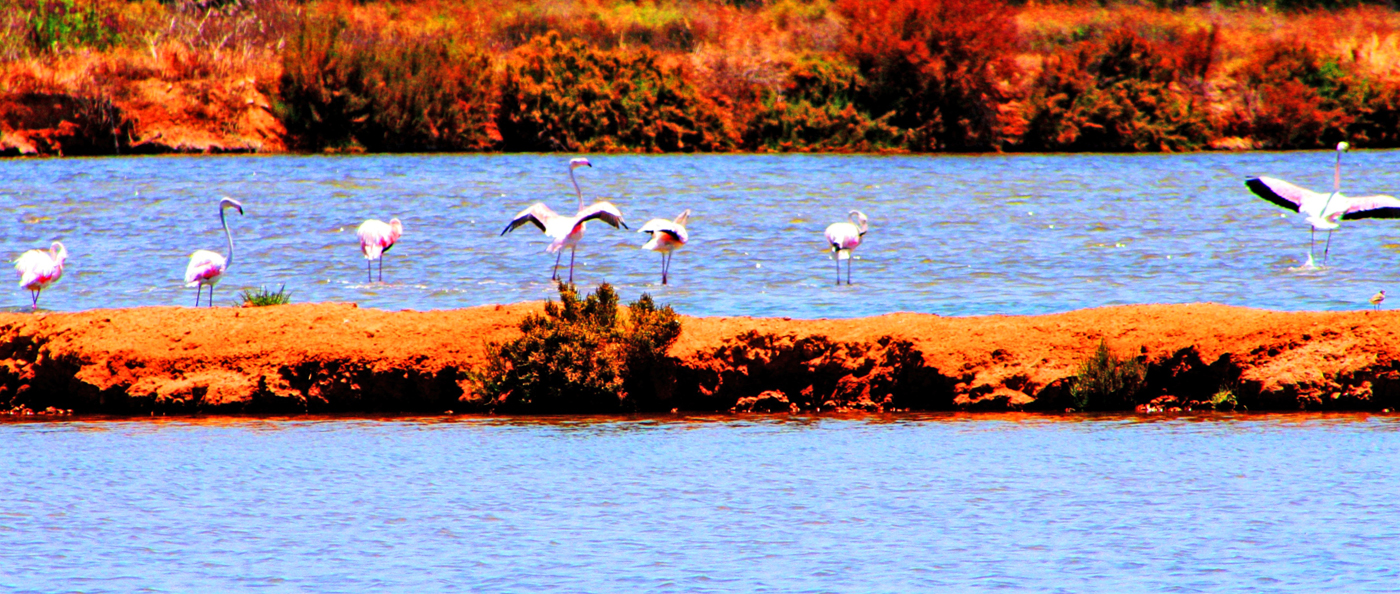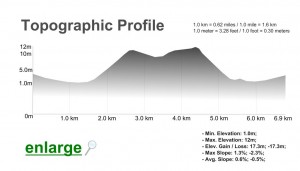
TRAIL FACTSHEET
LUDO TRAIL | BIRDS & NATURE: SEE HERE
Location: Ludo, Faro/Almancil; Faro & Loulé municipalities; GPS Coordinates (decimal degrees): 37.016834 N, -7.988397 W; Grade: easy; Type: semi-loop path; the trail is signposted; Lenght: 6950 meters/ 4.32 miles; Average Completion Time: 3.5 hours; Best Time to Visit: all year round; Activities: nature walks; cycling; birdwatching;
Ecologically significant, the saltpans are a prime habitat for a large array of waders and long-legged birds, such as the Spoonbill (Platalea leucorodia), the Grey Heron (Ardea cinerea) and the Black-winged Stilt (Himantopus himantopus). In case you are not coming directly from Quinta do Lago – and instead you aim to use the entry point suggested on the map below – at first you’ll see the lagoons on either side of the trail. Despite its proximity, these bodies of water are very different. The water on the right-hand side is brackish, which means that it sustains botanic species like the Spiny Rush (Juncus acutus) and an assortment of reeds and bulrushes, which in turn shelter a diversity of ducks, coots and moorhens.
You won’t spot ducks on the opposite side, though, but you might observe waders like the Kentish Plover (Charadrius alexandrinus) or the Greenshank (Tringa nebularia) probing the mudflats. That´s because tidal fluctuations on the left-hand side are much more pronounced. There, the slow moving saltwater brings about the presence of a very specific vegetation cover composed of salt tolerant plants (halophytes), like the luxuriant Limoniastrum (Limoniastrum monopetalum). Following the main route you’ll eventually reach a junction; here, you can either turn right or follow straight ahead. Choosing the latter, you will soon encounter the spot where a short but rather wide stream (the Ribeira de São Lourenço) intersects the saltmarsh. Depending on the season, here you’ll be able to observe Pied Avocet (Recurvirostra avosetta), Curlew (Numenius arquata), Black-winged Stilt, juvenile Flamingos and a large variety of ducks.
 The long, straight path then inflects to the right, superimposing the São Lourenço Trail. Located there, a large bird hide affords unobstructed panoramic views of the marshland. Then you’ll follow the last stretch of the São Lourenço Trail, until it intersects a wooded area with large Acacia and Eucalyptus trees. Look out for birds like the Hoopoe, the Azure-winged Magpie, and the Sardinian Warbler and then emerge out of the wooded area by turning right once more along the main path. At this point you reach the salt pans. On the left, there is a narrow gully where Mediterranean Turtles like to relax and sunbathe – however, you’ve got to be patient and keep very silent in order to observe these illusive creatures. Carry on along the main trail until you find another junction. A large and bright white pile of salt will perhaps be there, waiting to be shipped away. Turn right yet again, and you’ll be in between saltpans, where the Greater Flamingo (Phoenicopterus roseus) roams. The salterns are however quite extensive – in order to properly observe the pink beauties you should be carrying either binoculars or a camera with powerful lenses.
The long, straight path then inflects to the right, superimposing the São Lourenço Trail. Located there, a large bird hide affords unobstructed panoramic views of the marshland. Then you’ll follow the last stretch of the São Lourenço Trail, until it intersects a wooded area with large Acacia and Eucalyptus trees. Look out for birds like the Hoopoe, the Azure-winged Magpie, and the Sardinian Warbler and then emerge out of the wooded area by turning right once more along the main path. At this point you reach the salt pans. On the left, there is a narrow gully where Mediterranean Turtles like to relax and sunbathe – however, you’ve got to be patient and keep very silent in order to observe these illusive creatures. Carry on along the main trail until you find another junction. A large and bright white pile of salt will perhaps be there, waiting to be shipped away. Turn right yet again, and you’ll be in between saltpans, where the Greater Flamingo (Phoenicopterus roseus) roams. The salterns are however quite extensive – in order to properly observe the pink beauties you should be carrying either binoculars or a camera with powerful lenses.
If you do not locate flocks right away, try to follow the narrower, secondary tracks which will lead you right into the salt evaporation complex, but please bear in mind that there is no guarantee of seeing the birds, as their numbers oscillate wildly throughout the year without a defined pattern. Being so, the best option is to try a visit on another day, or in alternative try another nearby trail, such as the Pontal Trail or the Airport Trail* (please see here and here). You need to seek permission in order to access the narrow secondary tracks crossing the actual salt pans, since they are private property: a short and polite verbal exchange will suffice. Tagging along, you’ll note that different saltpans display different colours, from red or orange to yellow or pure white. The hue depends on the presence and relative abundance of a specialized and very primitive group of bacteria (Haloarchaea bacteria). To the west, there is a line of taller trees where the White Stork (Ciconia ciconia) nests. Following the main trail you are going to reach the initial junction. You can then turn left and return to your starting point, always surrounded by lovely Cistus (Cistus crispus) shrubbery. *The Airport Trail is yet to be described on the WalkAlgarve website
